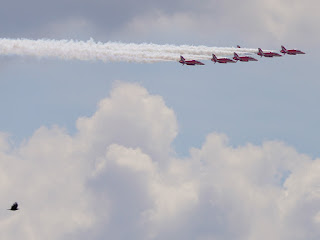The park was absolutely jammed with people for the Jubilee. I have never seen so many. The crowds were so thick at the Lido restaurant that the usual Starlings and Feral Pigeons that scavenge around the tables were having to stay on the roof.
I was filming a Reed Warbler singing beside the marble fountain in the Italian Garden when some fine old birds came over.
A Carrion Crow did its best to keep up with the Red Arrows.
A Blackcap sang beside the Long Water ...
... accompanied by a Chiffchaff in a treetop above it.
A young Blue Tit in the leaf yard called on its parents to feed it.
The young Grey Wagtail was hunting at the Serpentine outflow.
Virginia took this beautiful picture of a Pied Wagtail catching a midge on the Round Pond.
The family of Coots at the bridge were scooting all over the place, so I filmed a general view looking down from the parapet.
The Coots in the Italian Garden have built a fourth nest. Evidently the young Coots have found that they can get in and out of the netting by diving under it, as it only extends a few inches below the water. The parents are still flying over the top.
All three Mute Swan families have suffered casualties. I noticed this yesterday but waited till today to be sure I wasn't just overlooking some of the cygnets. The swans from the gravel bank are down to four ...
... and the dominant pair, shockingly, have only two left. I wondered if they had been fighting, but there is no evidence of that ...
... and on the other side of the bridge the pair with the extremely aggressive male are also down to four.
There were two pairs of Mandarins at the Vista, with no sign of ducklings, so it seems that their breeding attempts have come to nothing. The drakes are already going into eclipse and look sadly tatty, but the females are as elegant as ever.
There was also a solitary Red Crested Pochard drake, the first we've seen for some time. They used to visit often from St James's Park but seem to have lost the habit.
A Blue-Tailed Damselfly perched on a leaf near the bridge. The have have lovely iridescent eyes.
A warm day brought up algae in the Italian Garden fountains, which was promptly occupied by the Red-Eyed Damselflies that appear in this spot every year.
Duncan Campbell took this interesting picture of what he is fairly sure is a Lacewing larva eating Black Bean Aphids. An ant, which wanted to collect the sugary fluid excreted by aphids, looked on disapprovingly as its food source was consumed.






%202022%201a.jpg)








%202022%201a.jpg)
The old birds, and some newer ones were, as always, flying directly above us on the 4th floor, very close. Fantastic. Like my father, I'm not keen on things military, but love the planes. The LBBs nesting on top of my roof (for the 3rd year running now) seemed to remain clam, but one of them did fly off when the droning became too much. The other stayed on the nest.
ReplyDeleteDidn't know you had LBBs nesting on your roof. Have been curious about their nest sites in London as they begin to move in following the Herring Gulls.
DeleteEC1
DeletePrecious few manage to spend the night in EC1. I'm guessing the Golden Lane Estate, in the northern panhandle of that blighted region, where there are tall blocks that gulls might fancy as nest sites.
DeleteBourne Estate, 4/5 floors max. Leather Lane market with its food stalls may have drawn them here.
DeleteSimilar with the Paddington colony. Herring Gulls make the short flight to Church Street market. The owner of the fish stall throws trimmings on to the canvas roof of the stall for them.
DeleteLucky them: fresh fish. Leather Lane is mostly cooked 'streetfood' nowadays. I've only noticed the one pair of LBBs, and one or two juveniles; occasionally there's a few Herrings around - I don't know where they nest. Just recently a gang of Crows seem to have moved in . They're very adept at tearing open rubbish bags, to the delight of other birds, and the disgust of neighbours.
DeleteI've often seen crows tearing open rubbish bags. They are better at it than gulls despite having less powerful beaks, because of their prehensile feet. No doubt the local foxes account for a fair number of bags too.
DeleteNothing quite sounds as good as a Lancaster does. Lovely purring sound.
ReplyDeleteVery shocked to read swans are doing so poorly.
Tinúviel
Four Merlin engines sound wonderful, eight even better. I believe that one of the Hurricanes is on loan from Poland, temporarily painted in RAF colours.
DeleteLovely to see the Red-eyed Damselfly.
ReplyDeleteMust have been a special day with the various military aircraft overhead.
The Red-Eyed Damselflies always appear in exactly the same place, the south end of the southeast pond. A bit later the Small Red-Eyes also come out here.
Delete